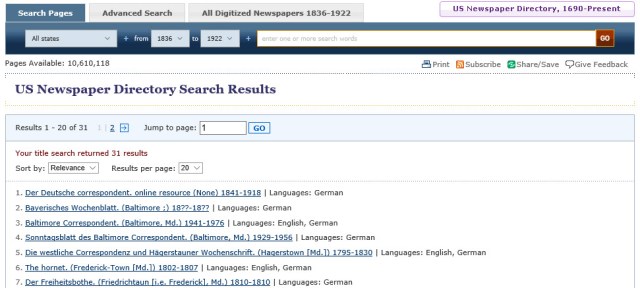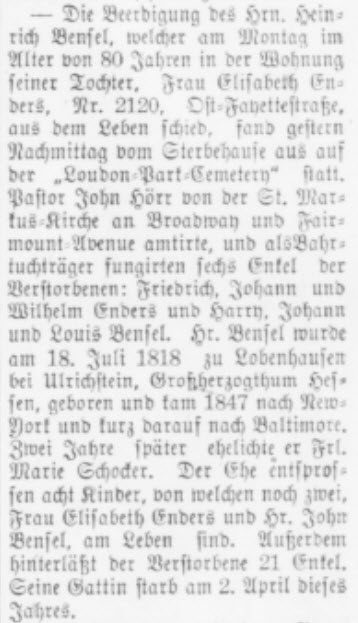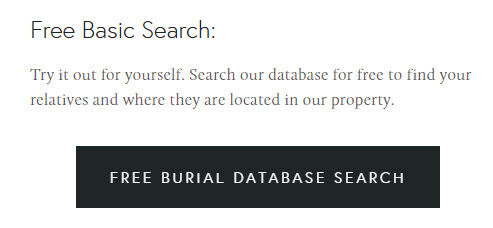One FREE resource that has been very valuable to me is from the Library of Congress, Chronicling America: Historic American Newspapers site. This post will cover some basic information for the site and an example of the value of using the site.
If you aren’t familiar, Chronicling America provides information and content for historic newspapers in the United States.
Information about newspapers – One of the cool things on the site is the U.S. Newspaper Directory, 1690-Present. This allows you to identify U.S. newspapers by locations and dates AND how they may be accessed. As of the writing of this post, there are 153,913 newspaper titles listed. The directory search allows you to search by various fields such as state, date, language, keywords, etc.
For example, I want to find information on what German newspapers were published in Maryland. I have a lot of German ancestors that immigrated to Maryland and many remained in Baltimore.
I fill out the search form as such:
 |
| Chronicling America Newspaper Directory Search for German Newspapers in Maryland |
Pressing “Search” gives me a list of results:
 |
| Chronicling America Newspaper Directory Search Results for German Newspapers in Maryland |
Clicking on any of the newspapers in the list will provide a page with tabs that have information on when the paper was published, where it was published, how often it was published and where it can be found:
 |
| About Täglicher Baltimore Wecker. (Baltimore [Md.]) 1867-1877 |
 |
| Libraries that Have It: Täglicher Baltimore Wecker. (Baltimore [Md.]) 1867-1877 |
Content – The other cool thing on the site is the content. They have free, yes FREE digitized historic newspapers from 1836 to 1922.
Disclaimer: They do not have all newspapers, nor do they always have entire published date range for a particular paper. As of the writing of this post, there are 10,610,118 digitized pages available.
For example, I want to see what digitized German newspapers are available for Maryland on the site.
I fill out the search form on the “All Digitized Newspapers 1836-1922″ tab”
 |
| All Digitized Newspapers 1836-1922 search |
The results show that there are 2 newspapers available:
 |
| All Digitized Newspapers 1836-1922 search results |
Next, we will look at an example of why I LOVE this site for my research. Let it be noted that I am lucky in that “Der Deutsche correspondent” covers the location and time period that I am interested in.
As I said previously, I have many German immigrant ancestors that came into Baltimore and decided to stay in Baltimore City, so it is very possible that “Der Deutsche correspondent” may have articles about my ancestors.
So for my example we are going to look at my 3rd great grandfather Heinrich Bensel.
I first found the exact death date for Heinrich in June of 2004. I narrowed his death down by searching using the U.S. Federal Census and the Baltimore City Directories and headed to the local library to search microfilmed newspapers starting in 1898. Finally in the July 19, 1898 edition of the “Baltimore News“. I found 2 articles.
On page 1 was a simple death notice that read:
BENSEL – Died. Monday, at 6:15 P.M., after a short illness, HENRY BENSEL, aged eighty years and five days.
The funeral will take place from the residence of his daughter, Elizabeth Enders, Wednesday, 20th inst., at 3 o’clock.
On page 11 I found a more extensive obituary that read:
Henry Bensel
Mr. Henry Bensel died yesterday morning at the home of his daughter, Mrs. Elizabeth Enders, 2120 East Fayette street. He was born July 13, 1818, in Germany. He emigrated to this country in 1847, two years later marrying Miss Mary Stocker. He was a skillful carpenter, at one time being in the active service of the Baltimore and Ohio Railroad until he was put on the pension list. His wife died on April 2 of this year. Two children survive him. They are John Bensel and Mrs. Enders.
A few months later I went to the Maryland State Archives and got his death certificate. There wasn’t much more information except that his “short illness” was thermic fever that he had for 4 days.
That is all the information I knew until I decided to search “Der Deutsche correspondent”. I searched Maryland papers for “Heinrich Bensel” and came up with several results around the date of his death.
The first one was on July 19, 1898, page 6, column 4:
 |
| “Der Deutsche correspondent” July 19, 1898, page 6, column 4 |
Well, the first problem is that I do not know German, Luckily, the site allows several options for seeing the page:
First, I saved and filed the PDF file to my computer.
Next, to try and “read” what this says I used the “Text” option. This displays the page in OCR text:
Then I searched the page for “Bensel” so I could find the section that had the article:
Next I highlighted the area of the text I wanted and did a Ctrl +C to copy the text.
Now I head to Google Translate and paste my OCR text and see what happens:
 |
| Google Translate results |
You will notice that because of the line breaks in the original, some of the translation doesn’t work. By editing the German side and taking out the breaks I get a better result:
 |
| Google Translate results after editing |
You will see that this article does not give me any more information than I already had. Actually, there is some conflicting information. Did he come to Baltimore in 1842 like the German paper said, or 1847 like the American paper said?
Further searching found an article about his funeral in the July 21, 1898 edition on page 6, column 8:
 |
| “Der Deutsche correspondent” July 21, 1898, page 6, column 8 |
I tried the same process for translating the article in Google translate and no matter how much massaging I did I just couldn’t get a good translation. Since I don’t read German, I cannot recognize all of the OCR mistakes that the article may contain.
No worries, there are plenty of resources to help with the translation.
My first stop will be social media. In my case, that worked. I took a screenshot of the article and headed over to the Genealogy Translation group on Facebook. This is a closed group but it has been so very helpful to me in translating documents.
I posted my request at 4:40 PM on March 14 and had a translation at 8:13 PM:
The burial of Mr. Heinrich Bensel, who passed from this life on Monday at the age of 80 years in the home of his daughter, Mrs. Elisabeth Enders, 2120 East Fayette St., occurred yesterday afternoon from the mortuary to the Loudon Park Cemetery. Pastor/Reverend John Hörr from St Martus Church on Broadway and Fairmount Avenue officiated, and six grand children of the deceased acted as pallbearers: Friedrich, Johann and Wilhelm Enders and Harry, Johann and Louis Bensel. Mr. Bensel was born on 18th July 1818 in Lobenhausen near Ulrichstein, Grand Duchy of Hessen and came to New York in 1847, and shortly thereafter to Baltimore. Two years later he married Miss Marie Stocker. The marriage produced 8 children of which two, Mrs. Elisabeth Enders and Mr. John Bensel, are still living. Also surviving the deceased are 21 grandchildren. His wife died on the 2nd of April of this year.
This gave me so much more information to start looking at. I now have a church name to search records for, children to double-check to make sure I have them all, grandchildren to check (names and number of grandchildren). I also have an immigration city and and location of birth. I always assumed he came directly to Baltimore and I could never find his immigration information, Now I know I need to check New York. This article is the only place that gave me an exact location of birth.
Had I not been able to get an answer within the translation group, my next step would have been to reach out with local societies that I belong to to see if anyone within the society could help. I have had success with that in the past.
So, in summary:
1. Check out Chronicling America.
2. For your immigrant ancestors, take some time to investigate foreign language newspapers.
3. See if Google Translate can help with foreign language translation.
4. Seek help with translations from social media or local societies.
Happy searching!!






















